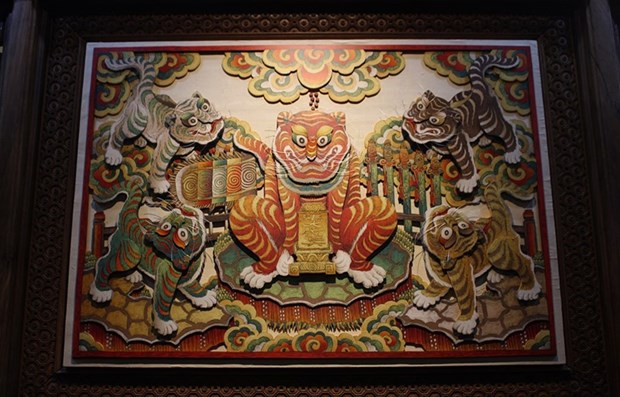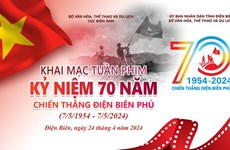Ngu Ho painting a message of brilliant colours
The colours in the “Ngu Ho” (Five Tigers) of the Hang Trong painting not only represent the Ngu Hanh, a combination of five elements - Kim (metal), Moc (wood), Thuy (water), Hoa (fire) and Tho (earth) - the universe of mutuality and contrast, and the living space of all things, but also convey dreams prosperity for the people.
 Photo: The “Ngu Ho” painting by young artist Xuan Lam, displayed at Nam Huong communal house in Hoan Kiem district, Hanoi is inspired by the original work of the Hang Trong painting (Photo: VietnamPlus)
Photo: The “Ngu Ho” painting by young artist Xuan Lam, displayed at Nam Huong communal house in Hoan Kiem district, Hanoi is inspired by the original work of the Hang Trong painting (Photo: VietnamPlus)The “Ngu Ho” painting is considered to have kept the beautiful purity of the Hang Trong painting style. The picture depicts the image of the “ong Ba Muoi” (tiger) with a majestic and powerful aura that stands out with five impressive and high-contrast colours.
However, not everyone understands the meaning, the layout or the implication of the colours on the picture.
Ngu Ho – Ngu Hanh
The symbol of tigers appears everywhere, in the spiritual world, in the beliefs and spiritual life of Vietnamese people.
The descriptions of tigers mostly represent a common folk concept of "ong Ho" (Mr. Tiger) which is a symbol of courage, power, flexibility and mystery, according to folklore experts.
Researchers said the ancients put the “Ngu Hanh” (five elements) rules into the five tigers to express the wish to send people to the five directions to protect them from evil forces.
The five tigers in the “Ngu Ho” picture of Hang Trong folk painting represent Ngu Hanh, the universe of mutuality and contrast which creates the living space of all things, including humankind.
Thanh Ho (blue tiger) belongs to the element of wood, representing the spring and guarding the east. Thanh Ho (blue tiger), Xich Ho (red tiger), Bach Ho (white tiger), and Hac Ho (black tiger) belong to the elements of wood, fire, metal, and water respectively, symbolising the seasons of spring, summer, autumn and winter, and guarding the east, south, west and north.
 Photo: A “Ngu Ho” painting exhibited at the Vietnam National Fine Arts Museum (VNFAM) (File photo)
Photo: A “Ngu Ho” painting exhibited at the Vietnam National Fine Arts Museum (VNFAM) (File photo)In the middle is Hoang Ho (yellow tiger) belonging to the earth and representing the centre.
According to the concept of the yin-yang theory, Kim, Moc, Thuy, Hoa, and Tho are the five basic factors that are necessary for all things in the universe.
Hang Trong Folk Paintings are one of the most outstanding folk painting genres in Vietnam. The art genre, a combination of traditional cultural values with ancient artistic methods, contributed to the development of folk painting craft, making it flourish once upon a time.
There are two common types of Hang Trong paintings, one for worshipping and the other for Tet (Lunar New Year) decoration. Like other traditional art genres in the country, Hang Trong paintings are at risk of falling into oblivion.
To make a traditional Hang Trong painting, the craftsman starts with woodblocks to print black outlines, then draws details and finally colours the picture by hand.
In the traditional making of Hang Trong paintings, after printing black outlines and drawing details, craftsmen colour their pictures with pigments, and therefore the tone of Hang Trong paintings is usually bright and attractive with principal colours being pink, blue, green, red and yellow.
Because the main part of the process is made by hand, Hang Trong pictures are slightly different from one to another and so they become more valuable for fastidious customers in Hanoi. The paper used in making Hang Trong paintings is called ‘Xuyen Chi’.
One of the most popular folk painting genres in Vietnam, Hang Trong painting, is closely associated with the culture of the capital city of Hanoi./.











